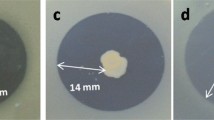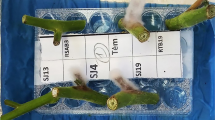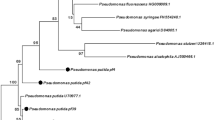Abstract
Bacterial canker of tomato, caused by Clavibacter michiganensis subsp. michiganensis, continues to be a problem for tomato growers in the Souss-Massa Draa valley, South of Morocco. Assuming that biological control is an alternative for the management of this disease, a total of 303 fluorescent pseudomonads strains isolated from roots and rhizospheric soil of tomato plants were in vitro tested against C. michiganensis subsp. michiganensis. Fluorescent pseudomonads strains which showed the highest antagonistic properties were thereafter investigated for their ability to colonize tomato roots. Our results showed that fluorescent pseudomonads are more represented in rhizospheric soils. However, the most efficient fluorescent pseudomonads isolates were found in the rhizoplane soil and the endorhizosphere. Among 42 spontaneous antibiotic resistant mutants obtained by treatment of the wild-type isolates with five antibiotics (rifampicine, nalidixic acid, ampicilline and chloramphenicol), 28 completely colonized the roots of all tomatoes seedlings used in this investigation. The 42 wild type isolates were then used for in vivo screening with the cotyledon test. Using this test, eight isolates from 42 tested induced a significant decrease of disease incidence and disease symptoms. The eight efficient isolates were then tested for their effectiveness in the protection of tomato plants in pots under greenhouse conditions. Results obtained showed that all tested isolates applied as seed and root treatments reduced significantly (P ≤ 0.001) the incidence of bacterial canker.


Similar content being viewed by others
References
Ahmad F, Ahmad I, Khan MS (2008) Screening of free-living rhizospheric bacteria for their multiple plant growth promoting activities. Microbiol Res 163:173–181
Ameziane N, Boubaker H, Boudyach EH, Msanda F, Jilal A, Ait Benaoumar A (2007) Antifungal activity of Moroccan plants against citrus fruit pathogens. Agron Sustain Dev 27(3):273–278
Barnett SJ, Singleton I, Ryder M (1999) Spatial variation in population of Pseudomonas Corrugata 2140 and Pseudomonads on take-all diseased and healthy root systems of wheat. Soil Biol Biochem 31:633–636
Berger G (1942) Une bactériose de la tomate nouvellement observée au Maroc. Ann Epiphyt 8:177–187
Boubyach EH, Fatmi M, Akhayat O, Benizri E, Ait Ben Aoumar A (2001) Selection of antagonistic bacteria of Clavibacter michiganensis subsp. michiganensis and evaluation of their efficiency against bacterial canker of tomato. Biocontrol Sci Tech 11:141–149
Boudyach EH, Fatmi M, Boubaker H, Ait Ben Aoumar A, Akhayat O (2004) Effectiveness of fluorescent pseudomonads strains HF 22 and HF 142 to control bacterial canker of tomato. J Food Agr Environ 2(3&4):115–120
Chaldecott MA, Preece TF (1983) The use of a tomato cotyledon test to identify Corynebacterium michioganense pv. michiganense. Plant Pathol 32:441–448
Cook RJ (1993) Making greater use of introduced microorganisms for biological control of plant pathogens. Annu Rev Phytopathol 31:53–80
Davis MJ, Gillaspie AG, Vidaver AK, Harris RW (1984) Clavibacter: a new genus containing some phytopathogenic coryneform bacteria. Int J Syst Bacteriol 34:107–117
Dey R, Pal KK, Bhatt DM, Chauhan SM (2004) Growth promotion and yield enhancement of peanut (Arachis hypogaea L.) by application of plant growth-promoting rhizobacteria. Microbiol Res 159:371–394
Dommergues Y, Mangenot F (1970) Ecologie Micobienne du Sol. Masson et Cie, Paris
Fatmi M, Schaad NW (2002) Survival of Clavibacter michiganenesis subsp. michiganenesis in infected tomato Stems in California, Ohio and Morocco. Plant Pathol 51:149–154
Ferrona P, Deguine JP (2005) Crop protection, biological control, habitat management and integrated farming. A review. Agron Sustain Dev 25:17–24
Gleason ML, Gitaitis RD, Ricker MD (1993) Recent progress in understanding and controlling bacterial canker of tomato in Eastern North America. Plant Dis 77:1069–1076
Jiménez O, Contreras N, Nass H (2004) Xanthomonas albilineas causal agent of sugarcane (Saccharum sp.) leaf scald disease in states Lara and Yaracuy. Rev Fac Agro 21:231–241
King EO, Ward MK, Raney DE (1954) Two simple media for the demonstration of pyocyanin and fluorescein. J Lab Clinic Med 44:301–307
Latour X, Delorme S, Mirleau P, Lemanceau P (2003) Identification of traits implicated in the rhizosphere competence of fluorescent pseudomonads: description of a strategy based on population and model strain studies. Agronomie 23:397–405
Menzies JG, Jarvis WR (1994) Bacterial canker. In: Howard RJ, Garland JA, Seaman WL (eds) Diseases and pests of vegetable crops in Canada. The Canadian phytopathological society and the entomological society of Canada, Ottawa, pp 341–342
Mercado-Blanco J, Rodriguez-Jurado D, Hervas A, Jiménez-Diaz RM (2004) Suppression of Verticillium wilts in olive planting stocks by root-associated fluorescent Pseudomonas spp. Biol Control 30:474–486
Mew TW, Rosales AM (1986) Bacterisation of rice plants for control of sheath blight caused by Rhizoctonia solani. Phytopathology 76:1260–1264
Parke JL, Moen R, Rovira AD, Bowen GD (1986) Soil water flow affects the rhizosphere distribution of a seed-borne biological control agent, Pseudomonas fluorescens. Soil Biol Biochem 18:583–588
Schorth MN, Hancock JG (1982) Selected topics in biological control. Annu Rev Microbiol 35:453–476
Sutra L, Risède JM, Gardan L (2000) Isolation of fluorescent pseudomonads from the rhizosphere of banana plants antagonistic towards root necrosing fungi. Lett Appl Microbiol 31:289–293
Trivedi P, Pandey A, Palni LMS (2008) In vitro evaluation of antagonistic properties of Pseudomonas corrugates. Microbiol Res 163:329–336
Umesha S (2006) Occurrence of bacterial canker in tomato fields of Karnataka and effect of biological seed treatments on disease incidence. Crop Prot 25:375–381
Utkhede R, Koch C (2004) Biological treatments to control bacterial canker of greenhouse tomatoes. Biocontrol 49:305–313
Verma R, Naosekpam AS, Kumar S, Prasad R, Shanmugam V (2007) Influence of soil reaction on diversity and antifungal activity of fluorescent pseudomonads in crop rhizospheres. Bioresour Technol 98:1346–1352
Vidaver AK (1967) Synthetic and complex media for rapid detection of fluorescence of phytopathogenic Pseudomonas: effect of carbon source. Appl Microbiol 15:1523–1524
Weller DM (1988) Biological control of soil borne pathogens in the rhizosphere with bacteria. Ann Rev Phytopathol 26:379–407
Xu GW, Gross DC (1986) Field evaluation of the interaction among fluorescent Pseudomonas, Erwinia carotova and potato yields. Phytopathology 76:423–430
Zanón JM, Jordá C (2008) Eradication of Clavibacter michiganensis subsp. michiganensis by incorporating fresh crop debris into soil: Preliminary evaluations under controlled conditions. Crop Prot 27(12):1511–1518
Author information
Authors and Affiliations
Corresponding author
Rights and permissions
About this article
Cite this article
Amkraz, N., Boudyach, E.H., Boubaker, H. et al. Screening for fluorescent pseudomonades, isolated from the rhizosphere of tomato, for antagonistic activity toward Clavibacter michiganensis subsp. michiganensis . World J Microbiol Biotechnol 26, 1059–1065 (2010). https://doi.org/10.1007/s11274-009-0270-5
Received:
Accepted:
Published:
Issue Date:
DOI: https://doi.org/10.1007/s11274-009-0270-5




